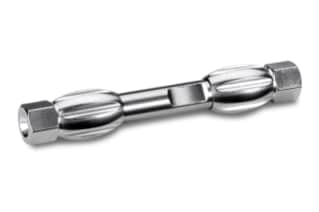
|
Chemistry |
C18 |
|
Separation Mode |
Reversed Phase |
|
Particle Substrate |
Hybrid |
|
pH Range Min |
2 pH |
|
pH Range Max |
11 pH |
|
Maximum Pressure |
6000 psi (415 Bar) |
|
Endcapped |
Yes |
|
Bonding Technology |
Shield RP18 |
|
Silanol Activity |
Low |
|
Particle Shape |
Spherical |
|
Particle Size |
3.5 µm |
|
Endfitting Type |
Waters |
|
Pore Size |
130 Å |
|
Format |
Column |
|
Surface Area |
185 |
|
System |
HPLC |
|
Particle Technology |
BEH |
|
USP Classification |
L1 |
|
Inner Diameter |
4.6 mm |
|
Length |
75 mm |
|
Carbon Load |
17 % |
|
UNSPSC |
41115709 |
|
Brand |
XBridge |
|
Product Type |
Columns |
|
Units per Package |
1 pk |

XBridge BEH Shield RP18 Column, 130Å, 3.5 µm, 4.6 mm X 75 mm, 1/pk
To get improved base separation, use the XBridge BEH Shield RP18 Column. When compared to straight chain alkyl columns, the incorporated carbamate group in the bonded phase ligand of the XBridge BEH Shield RP18 Column provides alternative selectivity, particularly for phenolic chemicals. Because of the 'Shield Technology,' the XBridge BEH Shield RP18 Column's designs result in reduced silanol interactions with basic analytes, assisting in the achievement of extremely symmetrical and efficient peaks. The 'Shielding' effect, which results in enhanced peak shape, is caused by the deactivation of basic analytes.
With the XBridge BEH Shield RP18 Column, you will enhance particle efficiency while relying on the lab equipment to produce unrivaled peak form and peak capacity. The XBridge BEH Shield RP18 Column was created with increased efficiency in mind. Improved pH stability results in higher column lifetime and assay robustness due to better dependability.
It is critical in chromatography to have reproducible column performance for reliable method development; thus, all Waters equipment is manufactured in dedicated state-of-the-art facilities to ensure you have equipment that can provide you with batch-to-batch reproducibility and stability of results. Every step of the manufacturing process is strictly managed and closely monitored within Waters facilities in accordance with the highest industry standards. Every XBridge BEH Shield RP18 Column is rigorously tested, from raw materials to the finished product, to ensure you have the highest quality goods in your laboratory.
Browse our brochure or visit our website to explore Waters' complete collection of all XBridge Columns, and you can quickly shop for lab equipment that meets your demands.
We also propose looking at the Waters XBridge BEH Shield RP18 XP VanGuard Cartridge, 130Å, 2.5 µm, 2.1 mm X 5 mm, 3/pk. These cartridges are utilized to increase analytical column lifetime and performance by removing particle pollution from the mobile phase stream. This cartridge has been designed to protect all 2.1 mm and 3.0 mm I.D. XBridge BEH Shield RP18 analytical columns with 2.5 µm sorbent particles.
What Is The Optimal Operational pH And Pressure Range For The XBridge BEH Shield RP18 Column?
The XBridge BEH Shield RP18 Column can operate optimally within a 2 - 11 pH range with up to 6000psi (or 415 Bar); however, you should be aware that operating the system and/or your column at temperatures or other settings such as pH and pressure close to or outside of the limit can have a significant impact on your column's lifetime and performance.